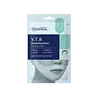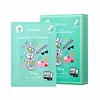What's inside
What's inside
 Key Ingredients
Key Ingredients

 Benefits
Benefits

 Concerns
Concerns

 Ingredients Side-by-side
Ingredients Side-by-side

Water
Skin ConditioningGlycerin
HumectantButylene Glycol
HumectantMethylpropanediol
SolventPolyglyceryl-4 Caprate
EmulsifyingAllantoin
Skin ConditioningMenthyl Lactate
MaskingAdenosine
Skin ConditioningDipotassium Glycyrrhizate
HumectantGlyceryl Acrylate/Acrylic Acid Copolymer
HumectantSodium Hyaluronate
HumectantAloe Barbadensis Extract
Skin ConditioningCentella Asiatica Extract
CleansingArnica Montana Flower Extract
MaskingAesculus Hippocastanum Extract
AntioxidantDisodium EDTA
Arginine
MaskingXanthan Gum
EmulsifyingAcrylates/C10-30 Alkyl Acrylate Crosspolymer
Emulsion StabilisingAmmonium Acryloyldimethyltaurate/Vp Copolymer
1,2-Hexanediol
Skin ConditioningCaprylyl Glycol
EmollientEthylhexylglycerin
Skin ConditioningLavandula Angustifolia Oil
MaskingPelargonium Graveolens Flower Oil
MaskingWater, Glycerin, Butylene Glycol, Methylpropanediol, Polyglyceryl-4 Caprate, Allantoin, Menthyl Lactate, Adenosine, Dipotassium Glycyrrhizate, Glyceryl Acrylate/Acrylic Acid Copolymer, Sodium Hyaluronate, Aloe Barbadensis Extract, Centella Asiatica Extract, Arnica Montana Flower Extract, Aesculus Hippocastanum Extract, Disodium EDTA, Arginine, Xanthan Gum, Acrylates/C10-30 Alkyl Acrylate Crosspolymer, Ammonium Acryloyldimethyltaurate/Vp Copolymer, 1,2-Hexanediol, Caprylyl Glycol, Ethylhexylglycerin, Lavandula Angustifolia Oil, Pelargonium Graveolens Flower Oil
Water
Skin ConditioningGlycerin
HumectantMethylpropanediol
SolventArginine
MaskingAmmonium Acryloyldimethyltaurate Crosspolymer
Emulsion StabilisingXanthan Gum
EmulsifyingAllantoin
Skin ConditioningPanthenol
Skin ConditioningButylene Glycol
HumectantSodium Hyaluronate
HumectantAloe Barbadensis Leaf Extract
EmollientLactobacillus Ferment Lysate
Skin ConditioningChamaecyparis Obtusa Water
MaskingPentylene Glycol
Skin ConditioningCaprylyl Glycol
EmollientHyaluronic Acid
HumectantHydrolyzed Hyaluronic Acid
HumectantRosa Damascena Flower Oil
MaskingRosa Damascena Flower Water
MaskingPhenoxyethanol
PreservativeBis-PEG-18 Methyl Ether Dimethyl Silane
EmollientPolysorbate 20
EmulsifyingDisodium EDTA
1,2-Hexanediol
Skin ConditioningEthylhexylglycerin
Skin ConditioningParfum
MaskingWater, Glycerin, Methylpropanediol, Arginine, Ammonium Acryloyldimethyltaurate Crosspolymer, Xanthan Gum, Allantoin, Panthenol, Butylene Glycol, Sodium Hyaluronate, Aloe Barbadensis Leaf Extract, Lactobacillus Ferment Lysate, Chamaecyparis Obtusa Water, Pentylene Glycol, Caprylyl Glycol, Hyaluronic Acid, Hydrolyzed Hyaluronic Acid, Rosa Damascena Flower Oil, Rosa Damascena Flower Water, Phenoxyethanol, Bis-PEG-18 Methyl Ether Dimethyl Silane, Polysorbate 20, Disodium EDTA, 1,2-Hexanediol, Ethylhexylglycerin, Parfum
Ingredients Explained
These ingredients are found in both products.
Ingredients higher up in an ingredient list are typically present in a larger amount.
1,2-Hexanediol is a synthetic liquid and another multi-functional powerhouse.
It is a:
- Humectant, drawing moisture into the skin
- Emollient, helping to soften skin
- Solvent, dispersing and stabilizing formulas
- Preservative booster, enhancing the antimicrobial activity of other preservatives
Allantoin is a soothing ingredient known for its protective and moisturizingg properties. Because of this, it is often added to products with strong active ingredients.
Studies show higher concentrations of this ingredient can promote wound healing.
Though it can be derived from the comfrey plant, allantoin is produced synthetically for cosmetic products to ensure purity.
Learn more about AllantoinArginine is an amino acid that is important for human development. Your body uses is it to produce hair keratin and skin collagen.
As a cosmetic ingredient, Arginine has antioxidant properties and can also help repair damaged skin. This ingredient is derived either synthetically or from animals.
Arginine isn't fungal acne safe when used in the presence of other lipids (fats, fatty acids, oils, esters, etc). Oils and fats occur naturally within the skin, so take caution when using Arginine if you're prone to fungal acne.
Learn more about ArginineButylene Glycol (or BG) is used within cosmetic products for a few different reasons:
Overall, Butylene Glycol is a safe and well-rounded ingredient that works well with other ingredients.
Though this ingredient works well with most skin types, some people with sensitive skin may experience a reaction such as allergic rashes, closed comedones, or itchiness.
Learn more about Butylene GlycolCaprylyl Glycol is a humectant and emollient, meaning it attracts and preserves moisture.
It is a common ingredient in many products, especially those designed to hydrate skin. The primary benefits are retaining moisture, skin softening, and promoting a healthy skin barrier.
Though Caprylyl Glycol is an alcohol derived from fatty acids, it is not the kind that can dry out skin.
This ingredient is also used as a preservative to extend the life of products. It has slight antimicrobial properties.
Learn more about Caprylyl GlycolDisodium EDTA plays a role in making products more stable by aiding other preservatives.
It is a chelating agent, meaning it neutralizes metal ions that may be found in a product.
Disodium EDTA is a salt of edetic acid and is found to be safe in cosmetic ingredients.
Learn more about Disodium EDTAEthylhexylglycerin (we can't pronounce this either) is commonly used as a preservative and skin softener. It is derived from glyceryl.
You might see Ethylhexylglycerin often paired with other preservatives such as phenoxyethanol. Ethylhexylglycerin has been found to increase the effectiveness of these other preservatives.
Glycerin is already naturally found in your skin. It helps moisturize and protect your skin.
A study from 2016 found glycerin to be more effective as a humectant than AHAs and hyaluronic acid.
As a humectant, it helps the skin stay hydrated by pulling moisture to your skin. The low molecular weight of glycerin allows it to pull moisture into the deeper layers of your skin.
Hydrated skin improves your skin barrier; Your skin barrier helps protect against irritants and bacteria.
Glycerin has also been found to have antimicrobial and antiviral properties. Due to these properties, glycerin is often used in wound and burn treatments.
In cosmetics, glycerin is usually derived from plants such as soybean or palm. However, it can also be sourced from animals, such as tallow or animal fat.
This ingredient is organic, colorless, odorless, and non-toxic.
Glycerin is the name for this ingredient in American English. British English uses Glycerol/Glycerine.
Learn more about GlycerinMethylpropanediol is a synthetic solvent and humectant.
As a solvent, it helps dissolve other ingredients, helping to evenly distribute ingredients throughout the product. This ingredient has also been shown to have antimicrobial properties which makes it a preservative booster.
Methylpropanediol is able to add a bit of moisture to the skin. It also helps other ingredients be better absorbed into the skin, such as salicylic acid.
Learn more about MethylpropanediolSodium Hyaluronate is hyaluronic acid's salt form. It is commonly derived from the sodium salt of hyaluronic acid.
Like hyaluronic acid, it is great at holding water and acts as a humectant. This makes it a great skin hydrating ingredient.
Sodium Hyaluronate is naturally occurring in our bodies and is mostly found in eye fluid and joints.
These are some other common types of Hyaluronic Acid:
Learn more about Sodium HyaluronateWater. It's the most common cosmetic ingredient of all. You'll usually see it at the top of ingredient lists, meaning that it makes up the largest part of the product.
So why is it so popular? Water most often acts as a solvent - this means that it helps dissolve other ingredients into the formulation.
You'll also recognize water as that liquid we all need to stay alive. If you see this, drink a glass of water. Stay hydrated!
Learn more about WaterXanthan gum is used as a stabilizer and thickener within cosmetic products. It helps give products a sticky, thick feeling - preventing them from being too runny.
On the technical side of things, xanthan gum is a polysaccharide - a combination consisting of multiple sugar molecules bonded together.
Xanthan gum is a pretty common and great ingredient. It is a natural, non-toxic, non-irritating ingredient that is also commonly used in food products.
Learn more about Xanthan Gum